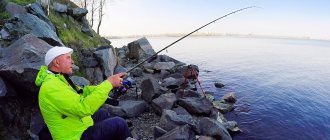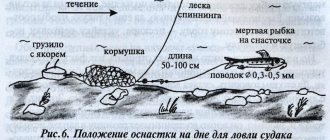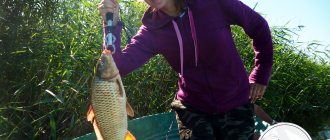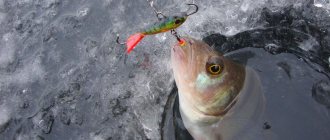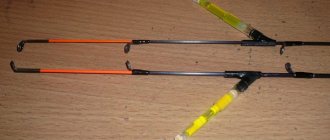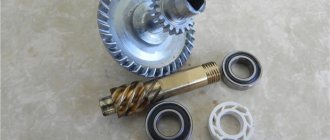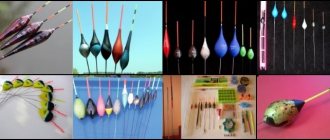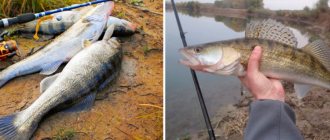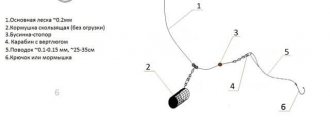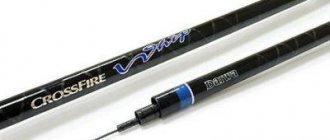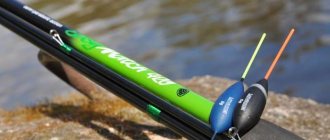It is applicable on rivers with different currents, as well as on canals. The most suitable technique for using a “torpedo” is to stop it at the point where the bait is located, as well as slow and stepped retrieves.
Fishing with a regular fishing rod is still practiced today, despite the presence of many types of gear, especially modern ones. This is due to the fact that such fishing brings a lot of positive emotions and does not make the angler bored.
At the same time, fishing with a float is fraught with some peculiarities. For example:
- When there is a current, the float is not located in one place.
- The float tilts and is not at a right angle.
- Since the float is in an unstable position, an illusory sensation of bites appears.
The main line should be thicker than the leader. Its length is usually equal to the length of the rod or several tens of centimeters more. The specific thickness is selected depending on the type of fish, the length of the rod and other factors.
Installation of equipment
It is convenient to fish with a fly rod, having various equipment options in stock. When choosing it, you need to take into account various factors.
Among them:
- The type of fish you are going to catch this time.
- The depth of the reservoir where you are going fishing.
- The presence of a current and its strength.
- Relief and features of the bottom.
- There may be other factors that can affect the size of the catch.
It will be convenient if you prepare several different gear options at home. Why can't you get by with just one of them?
Here we will talk about one of the options for installing equipment. As an example, we will look at one of the most typical options.
- The rod can be chosen in different lengths. One of the most common options is to take one that will be approximately five to six meters long.
- It is believed that the length of the fishing line should be approximately equal to the length of the rod. Some fishermen take its length to be thirty centimeters longer. A small loop should be made at the end that is supposed to be attached to the fishing rod. One option for this would be to use a figure eight knot.
- Now you need to attach the fishing line to the rod. Nowadays it is convenient to do this using a connector. It looks like this:
Trying to catch a good trophy using this technique is perhaps the most exciting pastime near the water. The method allows you to fish many areas of the reach from a certain place. Fishing in the current from a boat provides ample opportunities for fishing rod adherents, since catching from the shore is limited by coastal vegetation.
Dependence of wiring on the type of coils
Casting using inertia-free models does not allow the bait to move freely with the current and without jerking. The fish do not like this behavior of the food. To fix the problem, you need to work with the rod - point its blank in the direction of the current, and wait until the stick follows the float in a smooth arc, release about 2 meters of line from the reel, and return the rod to its original position. True, even this does not always help to avoid torn wiring.
Fishing stores offer a wide range of floats for fishing on the river. If you try, you can make any models, including flat floats for fishing on the current with your own hands.
Wiring fishing is ineffective without bait. But you shouldn’t throw food into the water without a certain system. To create an attractive trail that attracts a lot of fish, you need to follow these tactics.
Many beginners, when mastering fishing with a float rod and retrieving, make a simple mistake. After casting, they just release the line and wait for the bite. The fact is that the current speed in the bottom layer is lower than on the surface. Accordingly, the float moves faster than the bait, dragging it along with it.
Thanks to this combination, Stick are very sensitive to bites. But their main advantage is that when properly loaded, the movements of the bait on the hook look unusually realistic.
Bait for fishing in strong currents
Fishing in strong currents includes mandatory bait. It should be viscous, slowly wash out of the feeder or be slowly carried along the bottom by the current. Large particles should predominate in the bait, for example, pearl barley, corn, millet, etc. Also, for stickiness, various types of flour are added (pea, wheat, corn, semolina and regular).
Stores sell special bait designed for fishing in currents; it is already initially rich in large particles.
When preparing the mixture on the shore of a reservoir, clay or sand is added, which gives additional weight and helps the bait quickly reach the bottom, where it is slowly washed out.
It is very important to choose the right color of the mixture. Fish can be scared away by something that, although it smells delicious, is strikingly different from the bottom of the reservoir. If the fishing site has a sandy or clay bottom, then the bait should be light in color. Additional soil in the mixture is taken directly from the shore, sifted and mixed in a ratio of 50 to 50. Such bait should not contain loose materials, for example, crackers. They will wash out too quickly and the current will carry away most of the bait before it reaches the bottom.
Read! Catching rudd with a float rod
You can check the readiness of the bait by rolling a ball the size of an orange and throwing it in shallow water so that it is convenient to observe it. If the ball crumbles too quickly, then this mixture is not suitable.
Equipment for fishing on the current
The specificity of fishing on rivers is such that the bait on the hook must be quickly delivered into the depths. In addition, the rig’s own windage should be minimal. If the current is not very strong, a basic rig for fishing in lakes and canals will do just fine.
Only the main weights should be moved to one point and lowered a little closer to the hook (in photo 3 - Fig. 1). However, this option for installing equipment when fishing with wires is prone to frequent overlaps and tangling. To make your life easier, I recommend using olive weights, removable (photo 4) or sliding. Such equipment gets tangled much less, and adapting them to fishing conditions is much easier.
Which type of “olive”, fixed or sliding, is better is a controversial issue. I like to use sliding “olives” in cases where strong holding of the equipment is required, and the bait on the hook must drag along the bottom (in photo 3 - Fig. 2). In this way I often catch bream, podust and dace.
I always place at least two pellets closer to the hook. Their purpose is to reduce the inertia of the main load when biting. During the fishing process, I often move them up and down the line, thereby adjusting the gear to changing fishing conditions.
Loading floats Stick . In my arsenal of floats for fishing on currents there are unusual floats that are ideal for light fishing with short, up to 15 m, retrieve on rivers with a uniform moderate current. The peculiarity of these floats is that their body consists of two materials of different densities: the top of the float is made of light balsa, and the keel is made of plastic (photo 6) .
Thanks to this combination, Stick are very sensitive to bites. But their main advantage is that when properly loaded, the movements of the bait on the hook look unusually realistic.
To load Stick floats, I most often use the so-called “button pattern” for placing weights on the fishing line ( pictured 3 - Fig. 4). The sinkers are attached to the fishing line at the same interval - approximately 15 cm. In this case, their mass decreases as they move away from the float.
This arrangement of sinkers turns out to be very effective when fishing with light rig holds. At the same time, the bait slowly rises and again falls seductively to the bottom. If you have to fish at a depth of more than one and a half meters, I double the upper pellets, and 20 - 30 cm above the float I attach a small pellet to the fishing line, which slightly submerges the fishing line, thereby stabilizing the movement of the float in the water.
But these rigs also have one serious drawback: when casting over the head, the sinkers evenly distributed on the fishing line can get tangled. It is best to fish with this equipment when the equipment is pulled along the tip of the rod, and it is best to cast it with a side horizontal cast. This way the float will always point up and the hook will always point downstream.
I hope my tips for installing float rigs will help you correctly configure the rig for existing fishing conditions. Tight line for you!
- A rod with a reel is easier to use and transport.
- In a fishing rod without a reel, the line is attached to the tip of the rod, and the equipment is stored on a special reel separately from the rod. This rod is lighter than a rod with a reel and you can choose a longer option.
Choosing gear for fishing in the current
In the rapids they catch with a lapdog or a match. The first option is suitable for fishing near the shore and at medium distances, and the match allows you to cast the tackle as far as possible. The length of a match fishing rod is 3.6-3.9 m, and a lap rod is 5 m, less often 7 m.
The classic method used in strong currents is fishing with a wire. After casting, from time to time the angler slows down the movement of the tackle, at which time the fish most often overtakes the bait. With this fishing method, a float with a blind type of fastening is used, which can affect the possible fishing depth. But using a sliding float in a current is a bad idea, since rapid drift of the equipment often leads to tangling of the fishing line. However, in some cases you have to turn to the slipper for help.
The reel spool should be wound with a rigid and sinking fishing line, the optimal thickness of which is 0.2 mm. The float is heavy, with a load capacity of 6 to 10 grams. In very strong currents, round floats with a clearly visible antenna are used. The angler should not strain his eyes too much to find the bite indicator, so a thin antenna is not suitable.
Read! Fishing in the spring
The leader should be only slightly thinner than the main line, but it should not twist into a spiral due to the current. Therefore, fluorocarbon fishing line is perfect; with its rigidity, it will help the equipment stay level. If fishing occurs near the bottom, then the optimal length of the leash is 15-30 cm. If the leash is deep in the water, then 10 cm. Large bream is usually not embarrassed by this situation, it is not afraid of the tackle and will happily bite the bait. In this case, a rigid fishing line and a leash will help with landing a trophy specimen, since one should not forget that not only the fish, but also the force of the current will be against the angler. The ideal option would be to place a carabiner with a swivel at the end of the main fishing line in order to be able to quickly change leads based on the weight of the fish caught. If a roach weighing 250-300 grams greedily bites, then you can put a leash with a smaller diameter, 0.12 mm is quite suitable. And with the appearance of bream and bream, the leash is promptly changed to a more suitable one.
Nozzles
Don't expect the fish to bite on an empty hook - use bait and lures. In the spring and autumn seasons, it is preferable to use animal baits.
Animal baits that are sold in fishing stores:
- bloodworm;
- maggot (fly larva);
- dung and earthworm.
Plant attachments:
- dough;
- steamed corn;
- steamed pearl barley and other cereals.
If the bite is bad, use “sandwiches” - two different types of baits (maggot and worm, maggot and bloodworm, corn and maggot, etc.)
There is also an alternative option. On a piece of fishing line about half a meter long, at a distance of 1/3 from the edge, a loop measuring up to 15 cm is knitted. It will ensure the free movement of the feeder. A small loop is made on the remaining short end to attach the leash, and the long end is connected to the main fishing line through a clasp with a swivel. It is important to wet all hook and leader knots before tightening to prevent them from becoming deformed.
Rod and reel
Feeder fishing in a fast current has many different difficulties that require a reasonable approach to the choice of such elements of gear as a rod and reel. For fishing from a boat in deep areas, shorter rods are suitable, but when fishing from the shore, the length should be at least 3 meters.
It is advisable to install a high-quality and reliable reel, since a heavy feeder will create a serious load on it. You can use massive models if they do not radically disturb the balance of the feeder gear.
A reel is installed on the rod and securely fixed with a reel seat.
Catching bream in April with a float rod
It is safer to catch bream in April in reservoirs with standing water than in rivers.
The bite on the lake is stable and successful, because the fish come closer to the shore to spawn. When the spilled water warms up well, the bream moves to the grassy shallow water. If there are no bays, then it is nearby at a depth of one and a half meters. Read also: With a feeder for April bream
To fish from the shore, you need a fishing rod with a long rod and a flying float. Luck in April depends on the weather. Bream will prefer warm water, but will go deeper when the temperature drops. A serious bite is successful at water temperatures of eight to ten degrees Celsius.
It is imperative to feed fish in lakes in April in small portions. The nutrient balls should not fly into pieces when cast. But you shouldn’t overfeed the area, otherwise the bream will become lethargic and the bites will be weak.
This is interesting: Pea mastyrka for bream
On the river in quiet bays you can find bream; it is located on the border between current and standing water. The aggressiveness of the fish is taken into account when choosing a fishing line for a fishing rod. It should not be more than 0.25 millimeters. And the hook should be of medium thickness, but reliable and strong.
The bait is prepared from a mixture of peas with pearl barley and oatmeal or bloodworms with soil, slightly flavored. Nutrient balls are thrown upstream. In deep places, feeders are lowered.
